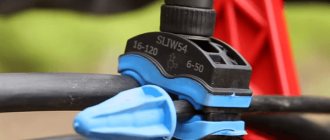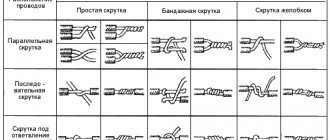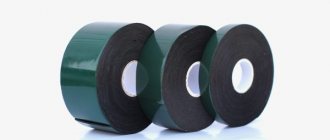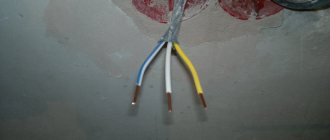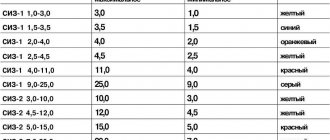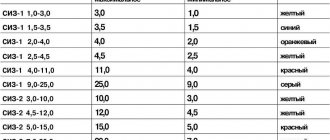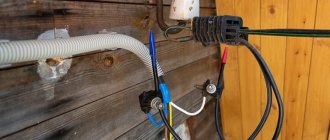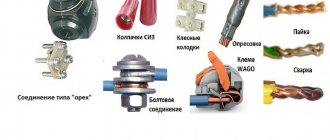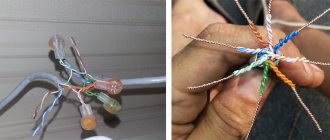SHARE ON SOCIAL NETWORKS
FacebookTwitterOkGoogle+PinterestVk
Any cable product has a current-carrying core, which is made of copper or aluminum. Since these materials are characterized by excellent current output and conductivity, during installation and connection there is often a need to connect them. How to connect copper and aluminum wires without making mistakes will be discussed below.
When moisture appears in the wire connection between copper and aluminum, electrolysis occurs, which can lead to aluminum burnout or fire
Copper and aluminum wires: are they really incompatible?
To understand all the intricacies of the procedure, you should understand what lies in such a connection. After all, there are different opinions regarding the fact that it is absolutely forbidden to connect copper wires with aluminum ones.
While some doubt whether it is possible to connect copper and aluminum wires, others successfully do it
Like any other metals, oxidation of aluminum and copper occurs with the participation of oxygen. As a result, an oxide film appears on their surface. And if the copper coating almost does not interfere with the flow of electric current, then the oxide coating represents a serious barrier to this.
The wire connection of copper and aluminum, no matter what, will be an impetus for the interaction of metals. Aluminum is characterized by a higher degree of activity. This means that between the connections, in the event of moisture, so-called electrolysis occurs - the transfer of aluminum ions to copper. As a result, the aluminum conductor loses its weight. Sinkholes and voids appear in it, which are also susceptible to oxidation and only accelerate electrolysis.
The result is an almost destroyed conductor, which is made of aluminum. As its cross section decreases, the degree of current density increases. In turn, this provokes heating of the metal. There are only two possible outcomes for this situation: either the aluminum burns out at the connection point, or a fire starts.
The impossible is possible, or how to connect copper and aluminum wire
While some doubt whether it is possible to connect aluminum wires to copper, many do it successfully. Moreover, there are a number of main generally accepted methods, thanks to which it is possible to eliminate contact between materials that act aggressively towards each other. Each of them requires separate attention.
The terminal block for connecting aluminum and copper wires can be equipped with either a clamping or bolt mechanism
How to Connect Copper and Aluminum Using Terminal Blocks
The terminal block for connecting wires can be equipped with a clamping or bolt mechanism. This design provides connection to two types of materials - aluminum and conductive. They contact each other through a steel plate. It is made from a neutral material that is not inclined to react with aluminum - often these are plates made of brass or tinned copper.
The wire block containing a bolt clamp is characterized by greater reliability and is used in low-voltage power circuits. Often this clamping is done using a “nut”. It is a small junction box made of dielectric materials. The device received this name due to its shape. Inside it there is a block of metal plates, through which contact is ensured between copper and aluminum wires.
Each of the above methods is a detachable connection. This means that, if necessary, you can repeatedly disconnect and connect them.
Note! Replacing the old wiring is recommended in any case. Copper has a load capacity that corresponds to the consumption of electrical devices. If it is not possible to perform a total replacement, it is carried out partially. Then the question arises of how to connect the wires correctly.
The most widely used terminal block for connecting wires is
The wire connection terminal, which is most widely used, is capable of connecting up to eight conductors with different cross-sections, and also allows you to attach it to a DIN rail using a special mounting adapter.
Features and secrets of using the crimping method
Sometimes in the process of installing and laying electrical wiring, the need arises to obtain a high-quality connection of wires. In this case, the connection of aluminum wires with copper is carried out by crimping using sleeves. Often, such a need appears at the stage of entry into electrical cabinets, switchgear, or when connecting a cable to an already installed unit, where there is no possibility of replacing copper with aluminum, and vice versa.
The presented type of conductor connection is characterized by high costs, since it involves the use of specialized equipment and tools. At the same time, in the process of performing repeated similar work, professionals often prefer this method.
Important! It is not recommended to fold conductors made of copper and aluminum in a direction parallel to each other, in other words, overlapping. The fact is that in such a case, copper and aluminum are in direct contact. In addition, it is better to avoid using bare copper sleeves in combination with a cable made of aluminum.
A reliable connection of aluminum wires with copper can be obtained using the crimping method using sleeves
By crimping the wires with sleeves, a more durable and reliable contact is guaranteed. In a similar way, aluminum and copper conductors are fastened in production even with powerful consumers.
To perform such work, special aluminum-copper sleeves will be required. If a manual hydraulic press is not available, they can be compressed using a standard hammer and aluminum pads.
This is interesting! It is recommended to use such compression when performing crimping not only with sleeves, but also with tips. By the way, they can also be made half of aluminum and copper. This allows you to connect the aluminum wire to various devices with terminals or leads made of copper.
Often, aluminum-copper sleeves are used to connect cable cores that have a large cross-section. If the cross-section is insignificant, a pair of conductors is crimped with a single sleeve. In this case, it is better to run the wires end-to-end - on both sides.
Crimping of cable cores with a small cross-section is carried out with one sleeve
A few words about the rules for bolting wires
Often, when working with electrical wiring at home, a person who is not involved in specific work may wonder how to reliably connect aluminum and copper wires. Naturally, in such a situation, there is no point in running to the market in order to purchase special tools. This is explained by the fact that the work is one-time in nature, but it is still necessary to complete it.
In such a case, a regular nut with a couple of washers and a simple bolt may well be used. In this method, the main thing is to separate two metals that are aggressive towards each other using washers.
Note! If you decide to give preference to a bolted connection, the steel washer can be replaced with a part made of brass. If you have metal at hand, you can even cut it out yourself. As for the option with a washer made of steel, it can only be used in those networks where the load is not too great.
Connecting copper wires to aluminum wires using a bolted method can be done in junction boxes. Without such structures it is impossible to imagine wiring, either in houses or in individual apartments. Thus, using a bolt, you can quickly and easily solve the question of how to connect stranded and single-core copper wire.
The connection of aluminum and copper wires by bolting can be carried out even in junction boxes
In a bolted connection, the rings formed from the wire must be screwed in the direction the nut is tightened. This is necessary in order to avoid unwinding of the rings and increasing their diameter during tightening. On the contrary, this method will promote a tighter turn around the bolt.
In addition, there is the option of using aluminum-copper washers and tips. There are several ways here:
- Crimp the aluminum cable using a lug and connect it to a busbar made of copper.
- Crimp a cable made of aluminum with a standard aluminum lug and connect to the bus using this washer.
How to connect copper to aluminum using the threaded method
Connecting wires using nuts and screws, if done correctly, is the most reliable solution and ensures proper contact throughout the entire life of the electrical wiring. The answer to the question of whether it is possible to connect copper and aluminum wires of different types using a threaded connection is a definite “yes”. Using a threaded connection, you can work with thick, single-core, thin, and multi-core wires. The main thing is to prevent direct contact between wires made of aluminum and copper.
Before connecting wires using a threaded method, you need to clean the metal until it shines and form rings
Before connecting electrical wires using a threaded method, you have to carry out preparations: remove the insulation from the conductors to a length equal to four times the diameter of the screw, in case of oxidation of the wires, clean the metal until the metal shines, and also form rings.
After this, the screw is ringed in the following order:
- spring washer;
- simple washer;
- ring of one conductor;
- simple washer;
- ring of another conductor;
- washer;
- screw.
When screwing the screw into the nut, the whole package is tightened until the spring washer straightens.
For conductors in which the core diameter does not exceed 2 mm, an M4 type screw will be sufficient. If the copper wire is stranded, first of all it is necessary to tinning it using solder.
Bolting wire connections is the most reliable solution
How to connect an aluminum wire to an aluminum one-piece method
The permanent type connection is endowed with all the advantages of a threaded type. The difference is only in a few points:
- the ability to disassemble and reassemble connections without disturbing the rivet;
- the need for special devices to carry out riveting.
Today, rivets have found wide application for permanent connections of thin-walled structural elements in the process of creating partitions. Efficiency, low price and strength are the main advantages of the presented type of permanent connection.
The essence of the functioning of the riveter is quite simple. It draws in and cuts steel rods threaded through a tubular rivet with a head made of aluminum. The rods are thickened, and as the rivet is pulled into the tube, it expands.
Using a riveter you can make not only permanent connections of thin-walled elements, but also reliably connect electrical wires
Note! There are rivets of different types, diameters and length variations. Therefore, everyone can choose the best option for performing personal tasks.
To connect conductors using a rivet, you will need to prepare them in the same way as for a threaded connection. The diameter of the rings should be slightly larger than the diameter of the rivet. The optimal size is 4 millimeters. The parts are put on the rivet in the following order:
- aluminum conductor;
- spring washer;
- copper conductor;
- flat washer.
Then a steel rod is inserted into the rivet gun and its handles are pressed until it snaps into place. This sound indicates that excess steel bars are being trimmed. That's it, the connection is complete.
Related article:
Connecting wires in a junction box for electrical wiring
Types and methods of installing distribution boxes. How to install it yourself.
The degree of reliability of both one and the second type of connection presented using a rivet is quite high. A similar connection method can be successfully used to splice damaged areas during the repair of conductors in the wall. However, it is imperative to ensure excellent insulation of the exposed joints.
Since rivets come in different types, diameters and lengths, everyone can choose the right option
How to connect aluminum wires using soldering
In the case of a large conductor cross-section (when mass is more important than strength), it would be rational to give preference to aluminum. The cross-sectional area of a wire made of aluminum will be several times larger compared to copper, and the aluminum part will still be twice as light as a copper one. If you ask people how to connect copper wires to each other, many will answer that it is better to do this by soldering.
You can solder wires made of aluminum in a junction box using a gas torch or soldering iron. The difficulty with using a soldering iron is that it is almost impossible to accurately heat it to the desired temperature. And in the case of aluminum, overheating is just as unacceptable as underheating.
Important! The metal is characterized by significant thermal conductivity, and melting can occur over a wide area from the soldering point.
It should be remembered that soldering copper to aluminum is not possible
Therefore, before connecting aluminum wires to each other, so as not to heat up, it is better to arm yourself with a gas burner. With its help, it is easier to adjust the heating temperature, but to use it you will have to prepare the surface for a long time. Nevertheless, it is better to give preference to the torch if it is necessary to solder massive parts. Be that as it may, soldering aluminum wires involves preparing them.
The difficulty of the soldering process is that aluminum is characterized by low fusibility, so if heated carelessly it can melt. The essence of another factor due to which the soldering process becomes more complicated comes down to the rapid oxidation of aluminum in air.
Although oxide deposits on the surface are a reliable protection of aluminum from negative external conditions, it also inhibits the adhesion of the material to the solder, so it must be removed.
Note! It is not possible to remove oxide deposits mechanically. The material immediately oxidizes and is covered with film again. You can only get rid of it mechanically by covering the surface with an oil layer.
Before soldering, the ends of aluminum conductors must be treated with oil.
The option with oil is completely inconvenient at home, and is also labor-intensive. The oil must first be calcined to 200 degrees to rid it of the oxygen present in it.
Thus, before soldering, the ends of aluminum conductors should be treated. The use of rosin or many other fluxes will not be effective due to the high degree of chemical stability of the oxide deposit. It does not dissolve even if organic acid is applied.
Note! In order to carry out tinning of wires, fluxes specially designed for this purpose and the mechanical method should be used simultaneously.
Naturally, a similar procedure should be performed until the wires are twisted. Otherwise, it will not be possible to clean the entire surface of the wire. Only the ends that have been tinned can be twisted together and then soldered.
You can solder aluminum wires using a gas torch or soldering iron.
Wires equipped with several cores should be soldered exclusively using a special flux, since their mechanical processing is almost impossible. A special feature of the soldering technology is that each of the wires must first be thoroughly processed using flux.
To do this, you will have to untwist and fluff the bundle. After the processing is completed, each of the thin wires of the core will need to be covered with a layer of solder and twisted into a bundle. After this, several ends are twisted and soldered.
Important! Situations may often arise when it is necessary to connect wires made of different metals. It should be noted here that soldering aluminum to copper is not possible.
The whole problem lies in aluminum. Due to its chemical and physical properties, aluminum cannot be soldered to another metal. If you decide to solder copper and aluminum using solder that is neutral to both metals, the different coefficient of temperature expansion will quickly destroy the contact. This is explained by the fact that during the passage of current through the conductor, it will definitely heat up, and after disconnecting it will cool down, and nothing can be done about it.
Special fluxes are used for tinning wires.
Studying the question of how to connect aluminum wires to each other when laying power wiring, it becomes clear that a standard soldering iron and sandpaper will not cope here. Therefore, before connecting copper wires to each other, you will need to arm yourself with knowledge regarding the basic principles of welding.
However, if we are talking about connecting wires that are made of different metals, it is better to immediately discard the idea of welding. This is due to the difference in temperature required to melt the metals. And such a procedure will not protect you from destructive electrolysis at all.
Twist
Aluminum wires are often connected to each other using twisting. This is the simplest, but also the most dangerous method of connecting wires to each other.
The sequence of actions when using this technology will be as follows:
- First, remove the insulation from the wires approximately 4-5 cm on each side. It is most convenient to use a special tool designed specifically for this purpose.
- Now the contacts should be degreased. To do this, you will have to wipe them with a cloth pre-moistened in acetone.
- Sandpaper is used to remove the oxide film from the surface of the metal, that is, to clean it until a metallic shine is obtained.
- The wires are crossed with each other, after which one of the wires is wound onto the other as tightly as possible using pliers.
- The second wire is wound onto the first in the same way.
- The twist should now be insulated using insulating tape. Professional electricians also recommend using a special heat-shrinkable tube or cambric. With its help, you can qualitatively protect the exposed area from the negative effects of the external environment.
In principle, the technology is quite simple. You just need to remember that the wires need to be exposed at least 4-5 cm, and the twisting should not be done manually, but only with the help of pliers, so that the wires fit as closely as possible to each other.
If this is not done, the result will be loose contact, which can cause the area to become very hot. In turn, this effect causes a short circuit, and in some cases even a fire.
How to connect an aluminum wire to a copper wire on the street: key features of the process
During the installation of cable lines in outdoor conditions, each of the connecting elements is exposed to the influence of negative environmental factors. Snow, rain, fog, and icing will definitely not contribute to high quality connections.
In this regard, to carry out such work, an exclusively sealed structure will be required. Moreover, it must be characterized by resistance to low temperatures and ultraviolet rays.
To make connections outdoors, you will need a sealed structure that is resistant to low temperatures and ultraviolet rays.
If you decide to make the connection outdoors, you should arm yourself with the knowledge of how to connect a SIP cable to a copper wire. After all, it is through this operation that you can connect copper and aluminum wires in open areas.
How to connect SIP and copper wire: features of each option
Depending on the location of the metering board, the SIP connection options may vary.
If the metering board is located on a line support, the connection is made through a solid conductor. Within the shield, it is directly connected to the machine. To connect conductors to the line, it is recommended to use a standard piercing clamp, which is specially designed for SIP lines.
This is interesting! Piercing clamps are designed to connect taps to the main line. Such specimens can be used to connect lines whose cross-section ranges from 16 to 120 mm2, and the tap cross-section ranges from 6 to 50 mm2. In this case, both SIP and a standard cable made of copper can serve as a tap.
It is recommended to use a standard piercing clamp to connect wires to the power line
The main compression elements are two plates with sharp teeth made of steel. When the mounting bolts are tightened, they come closer to each other and, at the moment of piercing the wire insulation, they create reliable contact and sealing of the fastening point. The bolts are tightened until they break, which is designed for a certain compressive force. Moreover, the design is disposable.
If it is decided to make the connection from the metering panel to the house using self-supporting insulated wires, then standard fittings are also indispensable. The best option would be to run the wire into the distribution box and connect it to the circuit breaker in the switchboard. In such a case, there is no need to connect it to the cable.
Note! To connect SIP with bare (uninsulated) wires, a special clamp should be used. It should have no sharp teeth on the side where the bare wire is attached.
If the metering board is placed on the wall of the house, the tap, which is connected to the main line by means of a clamp, is inserted into the metering board and connected to the machine. If the role of the sealing conductor is performed by the SIP, so-called anchor clamps are mounted on the support line and on the wall, providing fastening of the wires.
Special clamps are used to connect SIPs to bare wires
It may be necessary to connect a copper cable to a SIP wire if the site has several buildings and power distribution through them is carried out using SIP. In such a situation, installation can be performed using the method described above, using a ram or piercing type clamp.
We use modern pads with spring clamps
Not long ago, modified terminals equipped with spring clamps were introduced to the market of electrical equipment and components. Disposable (conductors are inserted without the possibility of their further removal) and reusable (equipped with a lever that allows you to remove and insert cables) terminals are available.
We use modern blocks with spring clamps. wago terminal blocks
| Terminal blocks wago | Current (A) | Number of connections wired | Conductor cross-section/(mm²) | Availability of contact paste |
| 222-413 | 32 | 3 | 0,08-4,0 | without paste |
| 222-415 | 32 | 5 | 0,08-4,0 | without paste |
Disposable terminal blocks allow you to connect single-core conductors with a cross-section within the range of 1.5-2.5 mm2. According to the manufacturers, such terminals can be used to connect cables in systems with currents up to 24 A. However, professional electricians are skeptical about this statement and do not recommend applying loads higher than 10 A to the terminals.
We use modern pads with spring clamps
Reusable terminals are equipped with a special lever (usually painted orange) and allow you to connect cables with any number of cores. The permissible cross-section of the connected conductors is 0.08-4 mm2. Maximum current – 34A.
To make a connection using these terminals, do the following:
- remove 1 cm of insulation from the conductors;
- lift the terminal lever up;
- insert the wires into the terminal;
- lower the lever.
Terminals without levers simply snap into place.
They are designed for connecting any types of single-core wires, including copper and aluminum wires with a cross-section from 1.5 to 2.5 mm2
As a result, the cables will be securely fixed in the block. The costs of making such a connection will be more significant, but you will spend much less time on the work and save yourself from the need to use any additional tools.
In a flat-spring clamp, the wire with stripped insulation is simply inserted into the hole of the Wago terminal until it stops. Electrical connectors with mortise contact

